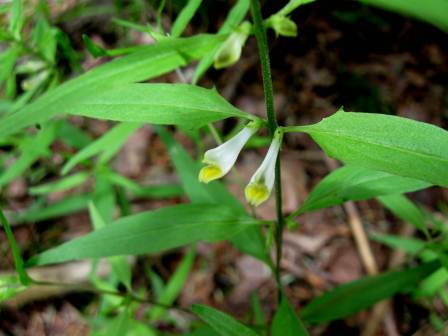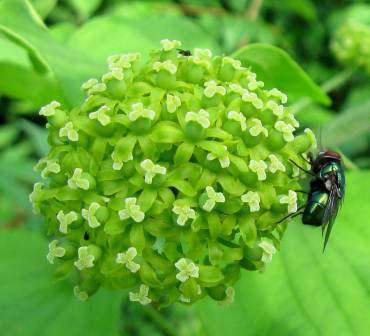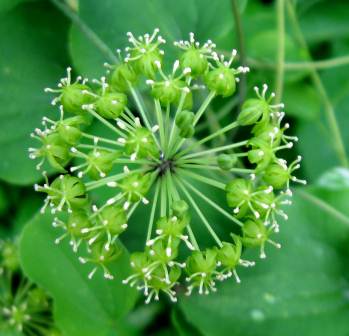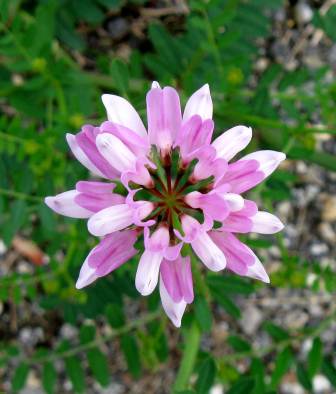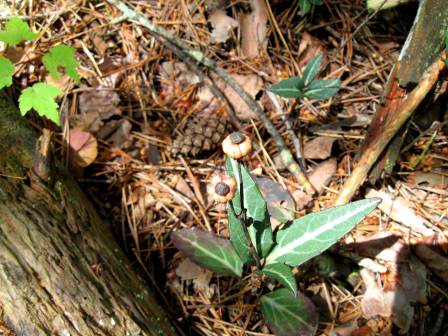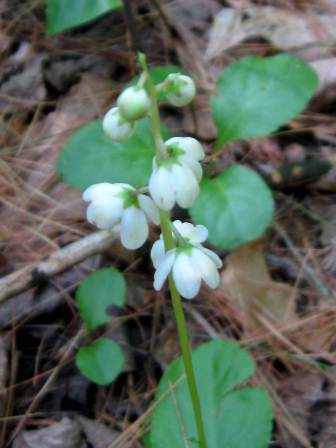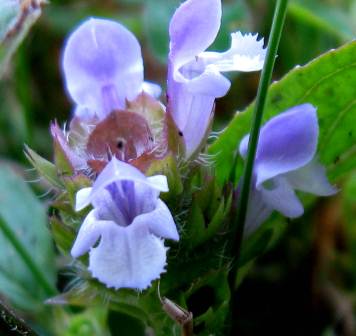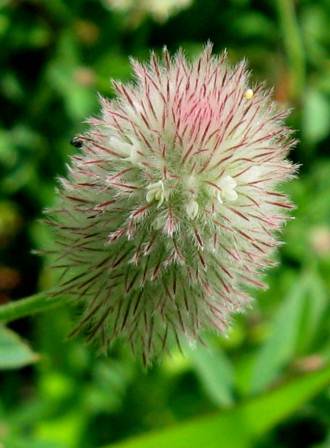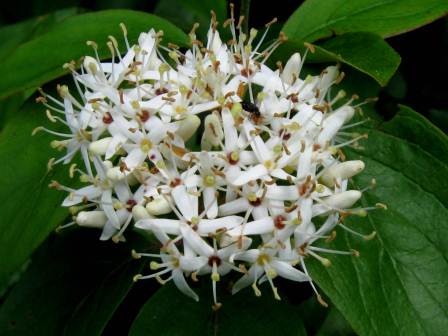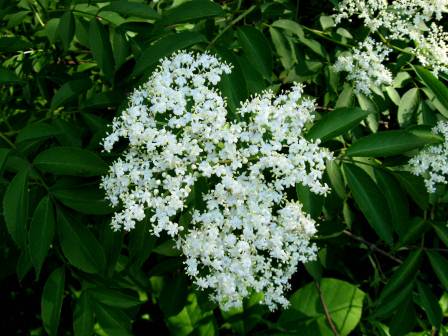There are days when I’m searching for wildflowers when I can go for hours without finding any, but those are also the days when I often see many other interesting things. It is those things “other than flowers” that will be found in this post. 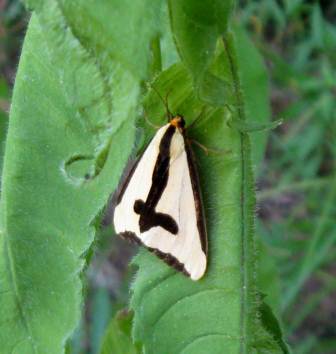 I found this Clymene Moth (Haploa clymene) hanging out on a wilted bee balm leaf. This one was quite easy to identify because of the upside down cross on its wings. (Some see a dagger) According to what I’ve read the larva feed on several different tree species including oak and willow. Clymene means “renowned one” in Greek. Apparently this moth is only found in the eastern part of the country.
I found this Clymene Moth (Haploa clymene) hanging out on a wilted bee balm leaf. This one was quite easy to identify because of the upside down cross on its wings. (Some see a dagger) According to what I’ve read the larva feed on several different tree species including oak and willow. Clymene means “renowned one” in Greek. Apparently this moth is only found in the eastern part of the country.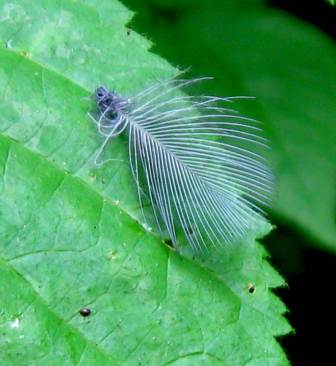 From a distance I thought this was another moth or a butterfly, but was a feather.
From a distance I thought this was another moth or a butterfly, but was a feather.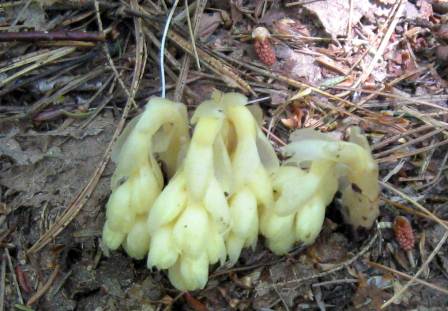 I found these pinesap plants (Monotropa hypopithys ) growing in a very dark, dry forest and was surprised to see them. They are a relative of Indian pipes (Monotropa uniflora) and like Indian pipes have no chlorophyll. They are also thought to be parasitic like Indian pipes. Pinesap plants have several flower buds on each stem and Indian pipes have only one. If these plants come up in the summer they are a yellow color like that in the photo, and if they come up in the fall they are usually a reddish color. I’ve been waiting a week or more for this group to stand up, but they haven’t yet. It’s almost as if they’re frozen in the position seen in the picture, because they haven’t moved.
I found these pinesap plants (Monotropa hypopithys ) growing in a very dark, dry forest and was surprised to see them. They are a relative of Indian pipes (Monotropa uniflora) and like Indian pipes have no chlorophyll. They are also thought to be parasitic like Indian pipes. Pinesap plants have several flower buds on each stem and Indian pipes have only one. If these plants come up in the summer they are a yellow color like that in the photo, and if they come up in the fall they are usually a reddish color. I’ve been waiting a week or more for this group to stand up, but they haven’t yet. It’s almost as if they’re frozen in the position seen in the picture, because they haven’t moved.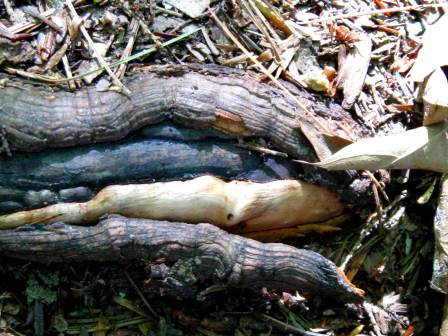 This pine root was in the middle of a trail I was following. How many shoe bottoms did it take to wear it away like this, I wondered. I love the way these worn roots look as if they have been carved, sanded and stained. I realized, while admiring this one that it would be an impossible to duplicate this by carving because the bark trying to cover over the wound is a large part of the whole.
This pine root was in the middle of a trail I was following. How many shoe bottoms did it take to wear it away like this, I wondered. I love the way these worn roots look as if they have been carved, sanded and stained. I realized, while admiring this one that it would be an impossible to duplicate this by carving because the bark trying to cover over the wound is a large part of the whole.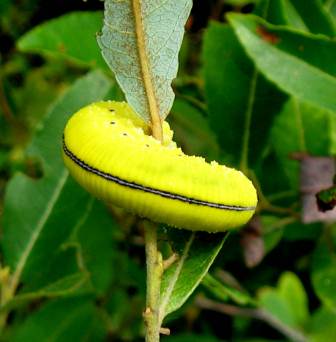 I thought this was a caterpillar on this willow tree but it turned out to be an Elm Sawfly Larva (Cimbex Americana.) These come in other colors like pink, white, green and gray, and like to hang out in willow trees. The elm sawfly is the largest species of sawfly in North America. In addition to the black stripe down their body they also have a row of black dots on each side of their body which can just barely be seen in this photo. The black dots are spiracles, or breathing tubes. These larvae also feed on elm, maple, cottonwood and birch but their favorites are willow and elm.
I thought this was a caterpillar on this willow tree but it turned out to be an Elm Sawfly Larva (Cimbex Americana.) These come in other colors like pink, white, green and gray, and like to hang out in willow trees. The elm sawfly is the largest species of sawfly in North America. In addition to the black stripe down their body they also have a row of black dots on each side of their body which can just barely be seen in this photo. The black dots are spiracles, or breathing tubes. These larvae also feed on elm, maple, cottonwood and birch but their favorites are willow and elm.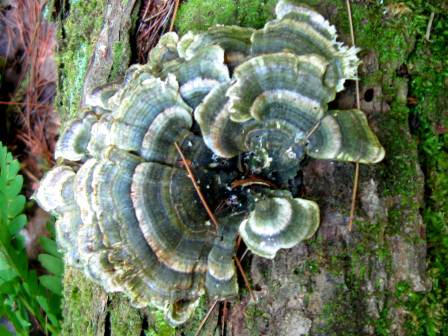 Turkey tails (Trametes versicolor) are a lot harder to see in the summer than they are in winter because of the undergrowth, but I still see them now and then. These were quite large and grew on a tree that had fallen across a trail.
Turkey tails (Trametes versicolor) are a lot harder to see in the summer than they are in winter because of the undergrowth, but I still see them now and then. These were quite large and grew on a tree that had fallen across a trail.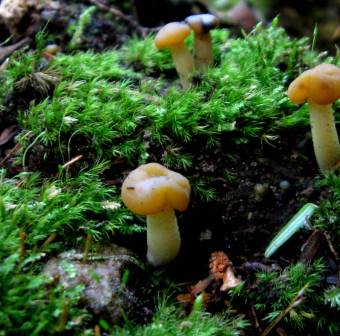 I sat down on a stone to take a break and turned and saw what I thought were red capped mushrooms growing on a moss covered stone. Each tiny cap was probably about half the diameter of a pencil eraser. Now that I see the detail in the picture though, I wonder if they aren’t young lipstick powder horns (Cladonia macilenta.) Since I’ve never seen lipstick powder horns I can’t be 100% sure but the description in the book Lichens of the North Woods comes very close to matching these. I wish I had checked them for gills but I didn’t want to destroy them just to satisfy my curiosity. I like to leave things as I find them so the next person can feel the same sense of discovery that I felt.
I sat down on a stone to take a break and turned and saw what I thought were red capped mushrooms growing on a moss covered stone. Each tiny cap was probably about half the diameter of a pencil eraser. Now that I see the detail in the picture though, I wonder if they aren’t young lipstick powder horns (Cladonia macilenta.) Since I’ve never seen lipstick powder horns I can’t be 100% sure but the description in the book Lichens of the North Woods comes very close to matching these. I wish I had checked them for gills but I didn’t want to destroy them just to satisfy my curiosity. I like to leave things as I find them so the next person can feel the same sense of discovery that I felt.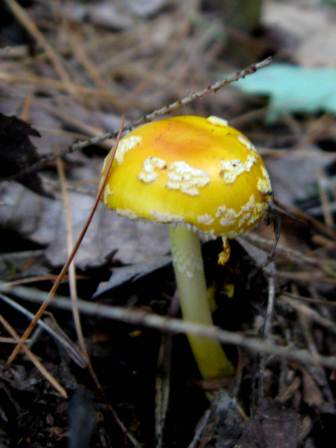 This one I do know without having to look it up. It is a yellow amanita muscaria, or fly agaric. The amanita family contains some of the most poisonous mushrooms known. Amanita muscaria with a red cap is supposed to be more common than yellow, but the yellow ones are all I ever see.
This one I do know without having to look it up. It is a yellow amanita muscaria, or fly agaric. The amanita family contains some of the most poisonous mushrooms known. Amanita muscaria with a red cap is supposed to be more common than yellow, but the yellow ones are all I ever see.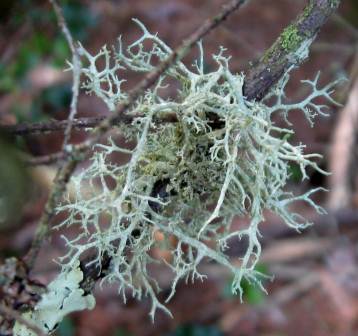 Like turkey tails, beard lichens are also harder to find in summer because of all the leaves on the trees but this one grew on a branch that was overhanging a beaver pond, making it easier to spot. This might also be Boreal Oak moss (Evernia mesomorpha) according to the book Lichens of the North Woods.
Like turkey tails, beard lichens are also harder to find in summer because of all the leaves on the trees but this one grew on a branch that was overhanging a beaver pond, making it easier to spot. This might also be Boreal Oak moss (Evernia mesomorpha) according to the book Lichens of the North Woods. 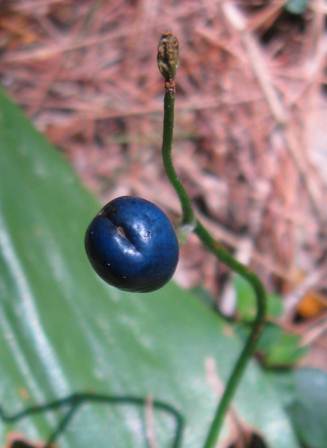 I know where several large colonies of blue bead lily (Clintonia borealis) grow and in the spring I saw hundreds of flowers. Not all flowers become fruit though; out of hundreds of blooms I’ve seen only two berries. It has taken a few weeks of searching to find them, but I’m glad that I did so I could show why the plant is called the blue bead lily. The fruit is certainly blue and is also said to be mildly toxic. It is supposed to have a terrible taste as well. Native Americans used the plant to treat bruises and burns and the root was used in a medicinal tea. The freshly dug root is said to attract bears.
I know where several large colonies of blue bead lily (Clintonia borealis) grow and in the spring I saw hundreds of flowers. Not all flowers become fruit though; out of hundreds of blooms I’ve seen only two berries. It has taken a few weeks of searching to find them, but I’m glad that I did so I could show why the plant is called the blue bead lily. The fruit is certainly blue and is also said to be mildly toxic. It is supposed to have a terrible taste as well. Native Americans used the plant to treat bruises and burns and the root was used in a medicinal tea. The freshly dug root is said to attract bears. 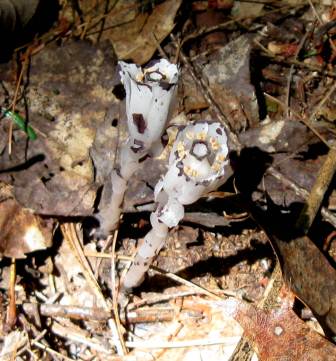 Indian pipe (Monotropa uniflora,) is a wildflower in the wintergreen family which is common enough but is usually seen with its flower nodding and pointing downward. When the flowers start bearing seeds they begin to dry out and slowly turn upright to the sky. The flower then becomes a fruit capsule before the plant finally turns brown and dries out completely. The Monotropa part of the scientific name means “one turn” for the way the flower turns once, from nodding to upright. Uniflora means one stem, because there is only one flower per stem.
Indian pipe (Monotropa uniflora,) is a wildflower in the wintergreen family which is common enough but is usually seen with its flower nodding and pointing downward. When the flowers start bearing seeds they begin to dry out and slowly turn upright to the sky. The flower then becomes a fruit capsule before the plant finally turns brown and dries out completely. The Monotropa part of the scientific name means “one turn” for the way the flower turns once, from nodding to upright. Uniflora means one stem, because there is only one flower per stem.  These seed heads of the yellow hop clover (Trifolium aureum ) look bright red to me but all of the books say that they’re brown so I’ll go with that for a color since I’m somewhat color blind. These seed heads are how the plant got its common name because someone, somewhere once thought they looked like hops. And they do-sort of. Each of the rounded parts that look like scales was a flower, and each holds one small seed.
These seed heads of the yellow hop clover (Trifolium aureum ) look bright red to me but all of the books say that they’re brown so I’ll go with that for a color since I’m somewhat color blind. These seed heads are how the plant got its common name because someone, somewhere once thought they looked like hops. And they do-sort of. Each of the rounded parts that look like scales was a flower, and each holds one small seed. I saw this gall on a willow branch one day and thought it looked a lot like the apple galls found on oak trees. The only difference is that it looks as if it has been pasted onto the branch with mud. I’ve spent many hours trying to identify this with no luck, so if anyone knows what it is I (we) would love to hear from you.
I saw this gall on a willow branch one day and thought it looked a lot like the apple galls found on oak trees. The only difference is that it looks as if it has been pasted onto the branch with mud. I’ve spent many hours trying to identify this with no luck, so if anyone knows what it is I (we) would love to hear from you.
Art is born of the observation and investigation of nature ~ Cicero
Thanks for visiting.


